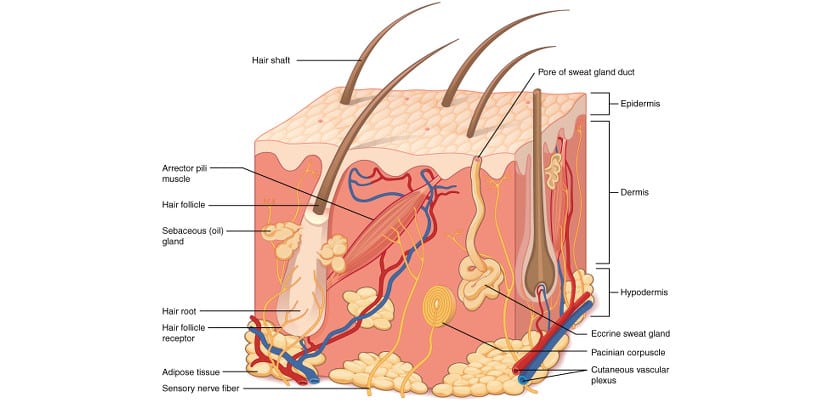
The layers of the skin (epidermis, dermis, and hypodermis) make up the largest organ in the body. Knowing them and learning how to take care of them has both aesthetic and health rewards.
Next, we explain what each layer is for and what you can do to keep them healthy and slow aging:
What are the layers of the skin for?

epidermis
The epidermis is the first of the layers of the skin, and also the thinnest. In addition to providing a protective barrier, it houses melanocytes, special cells that produce the pigment melanin. So It is the part where the responsibility of manufacturing the skin tone lies.
It is divided into five sublayers. Its outermost layer is the stratum corneum (stratum corneum), which contains dead cells. Some are removed naturally, while others require the use of exfoliating products. The rest of the sublayers are stratum lucid (stratum lucidum), stratum granulosa (stratum granulosum), stratum spinosum (stratum spinosum) and stratum basalis (stratum basale).
dermis
The second layer of the skin is called the dermis. Since it houses collagen, elastin and hyaluronic acid, plays an important role in keeping skin elastic and smooth. It should be noted that the dermis also contains hair follicles, blood vessels, sebaceous glands and nerves that make it possible to touch and perceive cold and heat.
Hypodermis
It is the third and last of the layers of the skin. The reduction of this adipose tissue causes sagging and wrinkles. It also houses sweat glands and has the task of conserving heat and protecting vital organs.
How to take care of the skin

As the years go by, the synthesis of collagen, elastin and hyaluronic acid decreases. Likewise, there is a reduction of fat in the face. All these unavoidable processes in the different layers of the skin cause the appearance of wrinkles and sagging. However, there are many things you can do to make wrinkles difficult:
Protect yourself from UV rays
To keep skin healthy inside and out it is very important not to expose yourself too much to UV rays, as they can cause spots and wrinkles, with skin cancers being their most serious adverse effect. In addition to using sunscreens with SPF 30 or higher (fortunately, most daytime moisturizers already have it in their formulas), there are other recommendations that must be taken into account. And not only in summer, but throughout the year:
- Covering your skin with clothing when outdoors
- Wear hats and sunglasses
- Avoid tanning beds
On the other hand, the skin produces vitamin D naturally when it comes in direct contact with the sun's rays. Vitamin D participates in the absorption of calcium from the body. It is also believed to play a role in preventing diseases such as dementia and some types of cancer.
However, dermatologists recommend getting vitamin D through diet rather than sun exposure. Salmon, tuna, egg yolk, and mushrooms are among the best natural sources of this nutrient. You can also get your daily dose of vitamin D through fortified milk and cereals, as well as with the help of nutritional supplements.
Adopt healthy habits
The effect of some habits is more significant than others, but practically everything you do throughout the day affects the condition of your skin. Training at least three times a week, sleeping 7-8 hours a day, and eating a balanced diet are among the beneficial habits. The harmful ones are tobacco, alcohol abuse, sedentary life and stress.
If you lead a healthy life and want your skin to be even more supple and hydrated, consider boosting the presence of omega fatty acids and antioxidants in your diet. You can get it through the following foods:
- Blue Fish
- Tomato
- Avocado
- Nuts
- Dark chocolate
- Sunflower seeds
- French Fries
- Peppers
- Broccoli
Create a solid hygiene routine

Cleaning and hydrating the skin every day is essential. Includes cleansers, scrubs, eye creams, hydrating creams, serums and body moisturizers in your personal care arsenal.
Cleansers remove dirt and sebum build-up. They leave the skin ready to absorb the rest of the products of your hygiene routine. Use lukewarm water and change your cleanser for an exfoliant (it can be physical or chemical) 1-2 times a week to remove dead cells for a more thorough cleaning.
Eye creams prevent dark circles and crow's feet, which are one of the first signs of aging in the face. Although many men skip this step, the truth is that it can make a big difference when it comes to facial skin and overall image.
Moisturizers help keep skin soft and glowing. As far as possible, they also delay the appearance of the signs of aging. Day, night and body are the three types of cream needed. You can also add one specially formulated for the feet if you consider it necessary.
For more complete facial hydration, consider combining your moisturizer with a serum. While the former remain in the outer skin layers, reinforcing its waterproof barrier, serums can penetrate deeper thanks to their smaller molecular structure.
Good information on the skin and to keep in mind. It is important to know how the skin is "formed" in order to take care of it and protect it. I keep reading you. All the best.